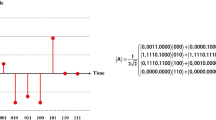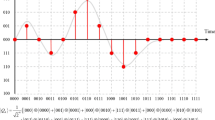Abstract
As a substitute for classical solutions, quantum information hiding techniques have become an essential issue in the field of quantum communications by utilizing the inherent features of quantum mechanics and creating more secured communications for the more reliable exchange of digital media within the context of quantum communications networks. Quantum steganography has been considered as one of these approaches in recent years, but the importance of investigating and discovering these hidden communications within the context of quantum communication networks that require the use of quantum steganalysis methods has not been addressed so far. Therefore, in this paper, a novel quantum steganography-steganalysis system for digital audio signals is proposed, which can accurately detect audio steganography methods in the context of quantum communication networks. The proposed model consists of two separate sections: steganography and steganalysis; in the steganography part, to minimize the impacts of the embedding process and increasing the Signal to Noise Ratio (SNR), the embedding operation is carried out within the Least Significant Fractional Qubit (LSFQ) of the amplitude information of the audio signal samples. Then, a universal steganalyzer in the steganalysis part distinguishes the stego audio signals using the extracted statistical features from the audio signals. The universal steganalyzer consists of a mean feature extraction module to extract features from the audio signal frames and the quantum circuits for implementing the K-Nearest Neighbor (KNN) algorithm and the Hamming distance criterion. The simulation-based quantum circuits of the proposed system tested and evaluated using different audio files. Over 80% accuracy in detecting stego audio signals indicates high accuracy and efficiency of the proposed scheme and its applicability in quantum communication networks. Along with the higher efficiency and security of quantum steganography methods when compared with the classical one, the results show that the proposed quantum steganography-steganalysis scheme is also capable of competing with classical methods in terms of accurately detecting steganography methods.













Similar content being viewed by others
References
Abdulla AA, Sellahewa H, Jassim SA (2019) Improving embedding efficiency for digital steganography by exploiting similarities between secret and cover images. Multimed Tools Appl:1–25
Aïmeur E, Brassard G, Gambs S (2013) Quantum speed-up for unsupervised learning. Mach Learn 90(2):261–287
Ali AH, George LE, Zaidan A, Mokhtar MR (2018) High capacity, transparent and secure audio steganography model based on fractal coding and chaotic map in temporal domain. Multimed Tools Appl 77(23):31487–31516
Aljawarneh S, Yassein MB (2017) A resource-efficient encryption algorithm for multimedia big data. Multimed Tools Appl 76(21):22703–22724
Atawneh S, Almomani A, Al Bazar H, Sumari P, Gupta B (2017) Secure and imperceptible digital image steganographic algorithm based on diamond encoding in DWT domain. Multimed Tools Appl 76(18):18451–18472
Bailey K, Curran K, Condell J (2004) Evaluation of pixel-based steganography and stegodetection methods. Imaging Sci J 52(3):131–150
Biamonte J, Wittek P, Pancotti N, Rebentrost P, Wiebe N, Lloyd S (2017) Quantum machine learning. Nature 549(7671):195
Böhme R (2010) Advanced statistical steganalysis. Springer Science & Business Media
Chandramouli R, Kharrazi M, Memon N (2003) Image steganography and steganalysis: Concepts and practice. In: International Workshop on Digital Watermarking. Springer, pp 35–49
Chen K, Yan F, Iliyasu AM, Zhao J (2018) A quantum audio watermarking scheme. In: 2018 37th Chinese control conference (CCC). IEEE, pp 3180–3185
Chen K, Yan F, Iliyasu AM, Zhao J (2018) Exploring the implementation of steganography protocols on quantum audio signals. Int J Theor Phys 57(2):476–494
Deutsch D (1983) Uncertainty in quantum measurements. Phys Rev Lett 50(9):631
Dunjko V, Briegel HJ (2018) Machine learning & artificial intelligence in the quantum domain: a review of recent progress. Rep Prog Phys 81(7):074001
Dunjko V, Taylor JM, Briegel HJ (2016) Quantum-enhanced machine learning. Phys Rev Lett 117(13):130501
Ekert A (2018) Quantum cryptography: the power of independence. Nat Phys 14:114–115
El-Khamy SE, Korany NO, El-Sherif MH (2017) A security enhanced robust audio steganography algorithm for image hiding using sample comparison in discrete wavelet transform domain and RSA encryption. Multimed Tools Appl 76(22):24091–24106
Gisin N, Thew R (2007) Quantum communication. Nat Photonics 1(3):165
Gupta B, Agrawal DP, Yamaguchi S (2016) Handbook of research on modern cryptographic solutions for computer and cyber security. IGI global
Hai H, Qing XD, Ke Q (2018) A watermarking-based authentication and image restoration in multimedia sensor networks. Int J High Perform Comput Networking 12(1):65–73
Heidari S, Pourarian MR, Gheibi R, Naseri M, Houshmand M (2017) Quantum red–green–blue image steganography. Int J Quantum Inf 15(05):1750039
Ibtihal M, Hassan N (2017) Homomorphic encryption as a service for outsourced images in mobile cloud computing environment. Int J Cloud Appl Comput (IJCAC) 7(2):27–40
Jiang N, Zhao N, Wang L (2016) LSB based quantum image steganography algorithm. Int J Theor Phys 55(1):107–123
Li P, Lu A (2018) LSB-based steganography using reflected gray code for color quantum images. Int J Theor Phys 57(5):1516–1548
Li J, Yu C, Gupta B, Ren X (2018) Color image watermarking scheme based on quaternion Hadamard transform and Schur decomposition. Multimed Tools Appl 77(4):4545–4561
Li P, Wang B, Xiao H, Liu X (2018) Quantum representation and basic operations of digital signals. Int J Theor Phys 57(10):3242–3270
Lloyd S, Mohseni M, Rebentrost P (2013) Quantum algorithms for supervised and unsupervised machine learning. arXiv preprint arXiv:02779
Long G-l, Deng F-g, Wang C, X-h L, Wen K, Wang W-y (2007) Quantum secure direct communication and deterministic secure quantum communication. Front Phys China 2(3):251–272
Luo G, Zhou R-G, Luo J, Hu W, Zhou Y, Ian H (2019) Adaptive LSB quantum watermarking method using tri-way pixel value differencing. Quantum Inf Process 18(2):49
Martin K (2007) Steganographic communication with quantum information. In: International Workshop on Information Hiding. Springer, pp 32–49
Mohsenfar SM, Mosleh M, Barati A (2015) Audio watermarking method using QR decomposition and genetic algorithm. Multimed Tools Appl 74(3):759–779
Mohtasham-Zadeh V, Mosleh M (2019) Audio Steganalysis based on collaboration of fractal dimensions and convolutional neural networks. Multimed Tools Appl 78(9):11369–11386
Mosleh M, Setayeshi S, Barekatain B, Mosleh M (2019) High-capacity, transparent and robust audio watermarking based on synergy between DCT transform and LU decomposition using genetic algorithm. Analog Integr Circ Sig Process 100(3):513–525
Nejad MY, Mosleh M, Heikalabad SR (2019) An LSB-Based Quantum Audio Watermarking Using MSB as Arbiter. Int J Theor Phys:1–24
Oppenheim AV (1999) Discrete-time signal processing. Pearson Education India
Pljonkin A (2019) Vulnerability of the synchronization process in the quantum key distribution system. Int J Cloud Appl Comput (IJCAC) 9(1):50–58
Qu Z, Cheng Z, Liu W, Wang X (2018) A novel quantum image steganography algorithm based on exploiting modification direction. Multimed Tools Appl:1–21
Qu Z-G, He H-X, Li T (2018) Novel quantum watermarking algorithm based on improved least significant qubit modification for quantum audio. Chin Phys B 27(1):010306
Qu Z, Cheng Z, Liu W, Wang X (2019) A novel quantum image steganography algorithm based on exploiting modification direction. Multimed Tools Appl 78(7):7981–8001
Rebentrost P, Mohseni M, Lloyd S (2014) Quantum support vector machine for big data classification. Phys Rev Lett 113(13):130503
Ruan Y, Chen H, Tan J, Li X (2016) Quantum computation for large-scale image classification. Quantum Inf Process 15(10):4049–4069
Ruan Y, Xue X, Liu H, Tan J, Li X (2017) Quantum algorithm for k-nearest neighbors classification based on the metric of hamming distance. Int J Theor Phys 56(11):3496–3507
Şahin E, Yilmaz İ (2018) A novel quantum steganography algorithm based on LSBq for multi-wavelength quantum images. Quantum Inf Process 17(11):319
Schuld M, Sinayskiy I, Petruccione F (2014) Quantum computing for pattern classification. In: Pacific Rim International Conference on Artificial Intelligence. Springer, pp 208–220
Sergienko AV (2018) Quantum communications and cryptography. CRC press
Shu-Jiang X, Xiu-Bo C, Xin-Xin N, Yi-Xian Y (2013) A novel quantum covert channel protocol based on any quantum secure direct communication scheme. Commun Theor Phys 59(5):547
Shu-Jiang X, Xiu-Bo C, Xin-Xin N, Yi-Xian Y (2013) Steganalysis and improvement of a quantum steganography protocol via a GHZ4 state. Chin Phys B 22(6):060307
Simmons GJ (1984) The prisoners’ problem and the subliminal channel. In: Advances in Cryptology. Springer, pp 51–67
Tirkel AZ, Rankin G, Van Schyndel R, Ho W, Mee N, Osborne CF (1993) Electronic watermark. Digit Image ComputTechnol Appl 666–673
Trugenberger CA (2001) Probabilistic quantum memories. Phys Rev Lett 87(6):067901
Vedral V, Barenco A, Ekert A (1996) Quantum networks for elementary arithmetic operations. Phys Rev A 54(1):147
Wang J (2016) QRDA: quantum representation of digital audio. Int J Theor Phys 55(3):1622–1641
Wang D, Liu Z-H, Zhu W-N, Li S-Z (2012) Design of quantum comparator based on extended general Toffoli gates with multiple targets. Comput Therm Sci 39(9):302–306
Wang S, Sang J, Song X, Niu X (2015) Least significant qubit (LSQb) information hiding algorithm for quantum image. Measurement 73:352–359
Wiśniewska J, Sawerwain M (2018) Recognizing the pattern of binary Hermitian matrices by quantum kNN and SVM methods. Vietnam J Comput Sci:1–8
Wootters WK, Zurek WH (1982) A single quantum cannot be cloned. Nature 299(5886):802
Xia Z, Wang X, Sun X, Liu Q, Xiong N (2016) Steganalysis of LSB matching using differences between nonadjacent pixels. Multimed Tools Appl 75(4):1947–1962
Yan F, Iliyasu AM, Guo Y, Yang H (2018) Flexible representation and manipulation of audio signals on quantum computers. Theor Comput Sci 752:71–85
Zhang Y, Lu K, Gao Y, Wang M (2013) NEQR: a novel enhanced quantum representation of digital images. Quantum Inf Process 12(8):2833–2860
Zhou R-G, Luo J, Liu X, Zhu C, Wei L, Zhang X (2018) A novel quantum image steganography scheme based on LSB. Int J Theor Phys 57(6):1848–1863
Zhou Y, Zhou R-G, Liu X, Luo G (2019) A quantum image watermarking scheme based on two-bit superposition. Int J Theor Phys 58(3):950–968
Author information
Authors and Affiliations
Corresponding author
Additional information
Publisher’s note
Springer Nature remains neutral with regard to jurisdictional claims in published maps and institutional affiliations.
Rights and permissions
About this article
Cite this article
Chaharlang, J., Mosleh, M. & Rasouli-Heikalabad, S. A novel quantum steganography-Steganalysis system for audio signals. Multimed Tools Appl 79, 17551–17577 (2020). https://doi.org/10.1007/s11042-020-08694-z
Received:
Revised:
Accepted:
Published:
Issue Date:
DOI: https://doi.org/10.1007/s11042-020-08694-z




